Josephine and I left Tucson October 1, at around 9:45 A.M., which is about 15 minutes earlier that we usually get away. Both of us were thankful that the entire trip was uneventful with regard to problems with the motor home. Both air-conditioners worked which kept the inside temperature very comfortable and the ol'e motor home, kept right on humming all the way to San Juan Bautista.
The first day out our goal is Barstow, California, a little over half way. We know if we can make it to Barstow, California we will have a short second day.
Because I have made the trip so many times it has become a chore, so I have divided the trip up into segments which I kid myself into thinking makes it more interesting therefore less tiring. If you think of a trip as 900 plus miles, much of it thorough desert landscape, that is bad news, almost two whole days of driving. But think it this way, rather than thinking of the entire 900 miles think of just 60 or maybe 80 or even 100 mile segments and it becomes a piece of cake, well maybe not a piece of cake but what the heck 60 miles is only one hour and we all know one hour isn’t that long.
Here we go, the first segment is Tucson to Casa Grande 60 miles, one hour more or less. Actually this stage is just to get us going, we try to become accustomed to the sounds, vibrations and feel of the motor home. Josephine enjoys being up close and personal with the 18-wheeler drivers. When the motor home passes a semi on her side she is close enough to reach out and touch the driver, she tells everyone she closes her eyes when we pass especially on mountainous roads. When Josephine gets a little tense from the traffic or road conditions she goes back and takes a nap, which is a great help to her.
So back to the trip, the heat isn’t bad maybe 95 to 100 degrees, the scenery is a little flat and ho hum but not terrible, the Palo Verde trees aren’t beautiful but they are green, because of the amount of rain we had this summer grass and weeds are growing which adds to the greenery, the freeway is clean thanks to Arizona’s policy of using prison inmates to pick up debris and we are paralleling the Southern Pacific Railroad, so I look for trains and think of the good old days when I was working on the railroad and Josephine tries to get used to the semis and her closeness to the right hand edge of the road. The right hand road edge isn’t a big deal on the wide freeway but on the narrow winding mountain road it does seem close setting on her side.
When we are traveling I think of historical events that have occurred along the route we are taking this keeps my mind off the tedium of the trip and sometimes makes the time pass more quickly. The first landmark is Pichico Peak a large 1,500-foot high rock monolith formation just off the freeway right-of-way. Pichico Peak is where the only battle of the Civil War occurred in Arizona territory. Union General Charlton was moving troops from California to the eastern theater of war when some Arizona militia troops decided to make a name for them. The battle lasted a few minutes, no one was hurt and each of the combatants went their own way.
Just about a mile before Pichico Peak is a farm where they raise emus for their meat. In case everyone does not know, an Emu is a large bird the size of an ostrich. I have never tasted Emus meat but it is suppose to be good to the taste and good for you because of its low fat and cholesterol. One reason people started raising emus is because of the high price their meat could be sold for and the fact the birds could tolerate the heat of the Arizona and New Mexico deserts. A few years ago a breeding pair of the birds were very expensive now I think now they are much less expensive. At any rate there is a large farm with from 100 to 200 birds.
When we get to Casa Grande I always make a routine stop to check out the tow dolly, the car and make a general visual walk around inspection to see if there is any obvious problem. Everything checked out and we are on our way again.
The second leg is also approximately 60 miles, Casa Grande to Gila Bend. This trip segment has more hills but the road is quite straight. We leave the railroad and start up grade gaining about 1000 feet of altitude. There are many Saguaro cacti growing through here, some Ocotillo, Palo Verde and some Creosote bush. We need to remember this is the Sonora desert. The thermostatically controlled cooling fan for the engine is on most of the time now and increases the noise level very noticeably. Without the fan being on there is not that much noise in the M.H. but with the fan on it sounds like a jet fighter plane.
Most of the route between Tucson and Gila Bend is where the Butterfield Stage Line ran. One thing we must remember when we consider likely routes for a stage line is the availability of water every thirty of forty miles. Back in the days of the stage lines the Santa Cruz River which parallels the stage route for a considerable distance had water in it the year around. Now the river, which enters into the United States from Mexico near, Nogales is dry most of the time. The other water source in the early times in this part of Arizona was the Gila River. In those days the Gila was a major year-round river that has it source in the Rocky Mountains of New Mexico and in the early days emptied its water into the Colorado River at Yuma. Now the riverbed still runs the entire distance but is now dry much of the time just west of Phoenix. Most of the water from the Gila is now impounded into a man made lake just south of Phoenix and used for the irrigation of cotton fields; actually I should say water is impounded that is not siphoned off by the city of Phoenix. Water is a scarce and interesting commodity in the arid southwestern part of the United States and a subject we will discuss at some length later on.
We leave Gila bend headed for Goodyear, Arizona 35 miles distance. Just a few miles out of Gila Bend is a rest stop, no shade, no facilities just a place to get off the road, this is where we have lunch. The plant life has dramatically gone down hill, by now about all there is creosote bush. The only thing of interest on this leg is a huge beautiful and brand new federal prison, juvenile detention center and landfill. Just before we get to Goodyear we cross the Gila River and see that it has some water in it, this is not a complete surprise but quite often it is dry. Just after crossing the river we enter an agricultural region with cotton crops. The cotton plants have many cotton balls displayed but it will be several more weeks before the cotton is ready to pick. All of the picking is now preformed by machinery.
Just past Goodyear we get back on I-10 and start one of the most boring segments of the trip. Goodyear to Quartzite is 100 miles of just about nothing. It is one of two legs of the trip I like least. The highway goes for miles straight as a string with almost no change in elevation, nothing, just creosote bushes.
For those who haven’t seen a creosote bush I will explain what it looks like. The bush is 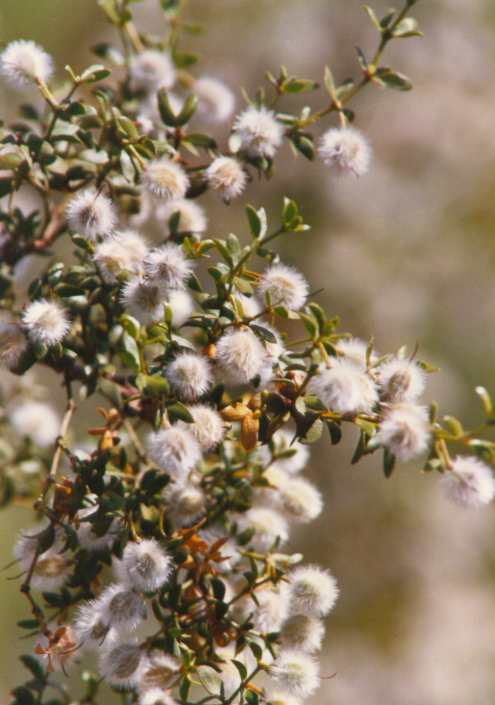 approximately five feet tall has a very small wax coated shiny leaf. The waxy coating is to help the plant retain its moisture and not loose it through transpiration. If the climatic conditions are favorable the plant gets a small but colorful bright yellow flower followed be a white furry-coated seedpod. There are a couple of things about the plant that are interesting.
approximately five feet tall has a very small wax coated shiny leaf. The waxy coating is to help the plant retain its moisture and not loose it through transpiration. If the climatic conditions are favorable the plant gets a small but colorful bright yellow flower followed be a white furry-coated seedpod. There are a couple of things about the plant that are interesting.
First they are most likely the widest spread plants in the Sonoran Desert, they are able to survive with the least amount of water and in the poorest soil of any plants in this part of the world. The second thing that is remarkable is that scientist now think they are the oldest continuously living plants on earth. For many years the Redwood or Sequoia was thought to be the oldest then it was the Bristle Cone Pine, now it is the creosote bush. What the assumption is based on is that scientist think many plants arranged in a circular form share a central root system and that this common root may have plants growing in a radius of several hundred feet. Some of the plants are thought to have been on earth long before the appearance of Christ.
O.K. we finally make it to Quartzite and breath a sigh of relief. Quartzite is a favorite wintering spot for snowbirds. During July the town has a population of a few hundred souls, during the winter months there are many thousand campers there. The mid-westerners stay because the climate is pleasant during winter months and it is the cheapest place to stay. There is absolutely nothing to do except rock hound and possibly go to the Colorado River, which is 40 miles away.
Our next goal is Parker, Arizona located on the east bank of the Colorado River. When we reach Parker it is time to make a pit stop for gas. We fill the gas tank make a walk-around visual inspection of the rig and proceed. When we leave Parker we cross the Colorado River and enter California. On the Arizona side of the river near Parker there is a swath of irrigated land planted in mostly hay crops thus making the area somewhat attractive and somewhat green. On the California side it is the most desolate country you will see, sand and not much else. I never fail to thing of the poor Oakie's coming from Oklahoma headed for California and seeing this desolate scene. It must have been heartbreaking.
Parker is 90 miles from Needles, California our next goal. After you cross the Colorado River the terrain is hilly for 20 miles until you get to Vidal Junction. At Vidal Junction there is an agriculture inspection station. The inspection requires you to stop and answer two questions. 1. Where are you coming from? 2. Do you have any fruit, plants or animals? After answering each question over the roar of our generator, which is running, to keep the roof air-conditioners going we are allowed to continue. Vidal to Needles is over a 1,500-foot hump. Not many plants although there is a sprinkling of Ocotillo, which can be colorful if it has rained recently.
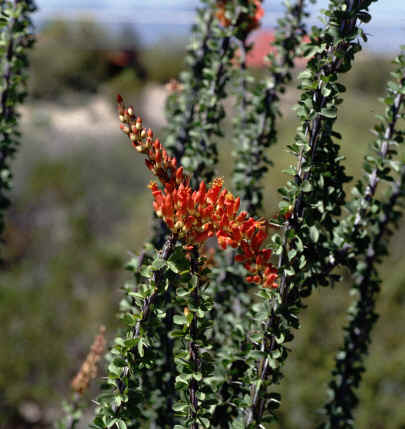 These plants appear to be dead most of the year but if it rains they will leaf out with a beautiful green leaves and often bloom with and equally beautiful red and yellow flower.
These plants appear to be dead most of the year but if it rains they will leaf out with a beautiful green leaves and often bloom with and equally beautiful red and yellow flower.
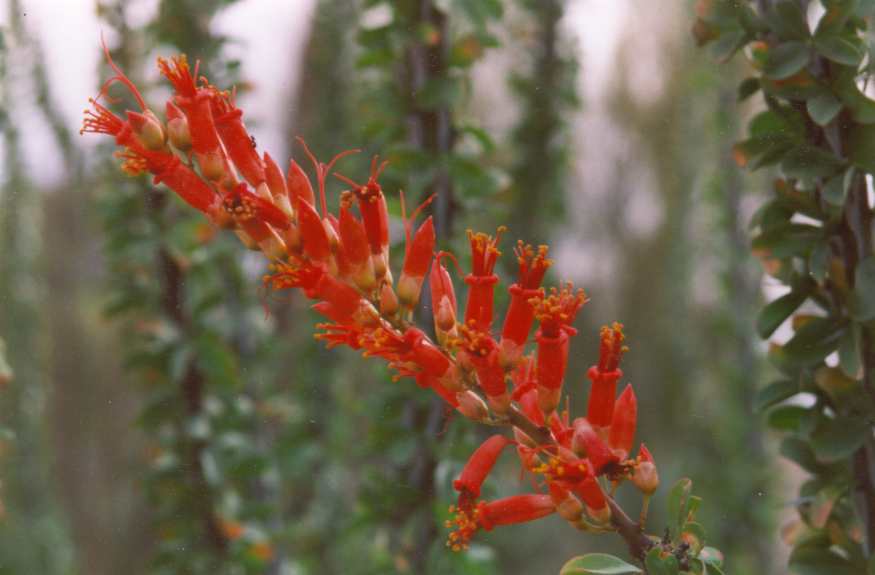
All in all this leg isn’t bad.
The dreaded Needles to Barstow is the next segment. This leg is 145 miles of no towns no nothing. Exactly 100 miles from Needles is Ludlow, a town of 2 gas stations and one restaurant after that nothing until just before you reach Barstow. As an aside on our return trip to Tucson Ludlow was the epi-center of an earthquake measuring 7.2 on the Richter scale. The quake was so severe it derailed a Santa Fe train and collapsed the freeway overpass connecting the two sides of town. We passed through the town at about 6:00PM and the quake hit at about midnight. We were asleep in the motor home at Needles and the quake woke both of us up. The quake was felt in Phoenix which is located 150 miles further east of Needles. If you have never felt a major earthquake it is an experience.
Just west of Needles is a 20-mile long grade that raises some 2000 feet in elevation. The last 2 miles are quite steep and it is a real chore for the motor home to get over it with the car towed behind. Added to the problem is that the temperature is often 110 or degrees or higher and with a head wind blowing at 20 or more miles per hour against you. Motor homes do not like headwinds. This is the leg I like the least.
With that said there are some things to that are of interest. First we are running parallel to the Santa Fe Railroad at least part of the way so we are able to watch a few trains pass. Also this is the route John Charles Fremont took when returning from his second exploration trip to California. Fremont returned to the United States via the San Joaquin Valley, the Tehachapi Pass then across the southwest desert to Saint Louis. The reason Fremont used this southern route was the warmer weather in the winter season. The old bug-a-boo water and feed for the animals is the drawback for this route. The last reliable water available going east from California is at Newberry Springs 20 miles east of Barstow and in those days the Mojave River had water in it but that water has dried up from over draft many years ago. From there to the Colorado River is about 2 to 3 days via horseback horses can’t go 3 days without water, men can. It was necessary to either find water or carry water on pack animals. In those days most explorers used Indian guides to find water and grazing fodder for the animals. There were several other Americans that traveled through this country even before Fremont one such person was Jedediah Smith. Remember that Fremont was not looking for a more reliable route for settlers going to California he was looking for a trans-continental railroad route to the west coast.
Another problem faced by riders crossing this part of the southwest is lava deposits. These formations are very hard on the feet of the horses. Even with proper shoes in good condition on the horse’s feet it is very damaging. The lava deposits are so wide spread it is a long way around them making it impossible to avoid them and still makes it between water holes. O.K. that’s enough lets just say it’s a long hard drive.
When we arrived at Barstow or more correctly Daggett, that is 5 miles east of Barstow, we pulled into our favorite motor home park for the night with the good feeling the worst was over for this trip. Josephine fixes us a nice supper, we watch some TV and get a good nights sleep.
Friday we feel better we have the two bad legs of the journey behind us and we are more than half way. Just west of Barstow we get into some more interesting country. First we see an unusual tree it is called a Joshua tree, its not pretty just different, it looks a little like a Yucca plant but much larger.
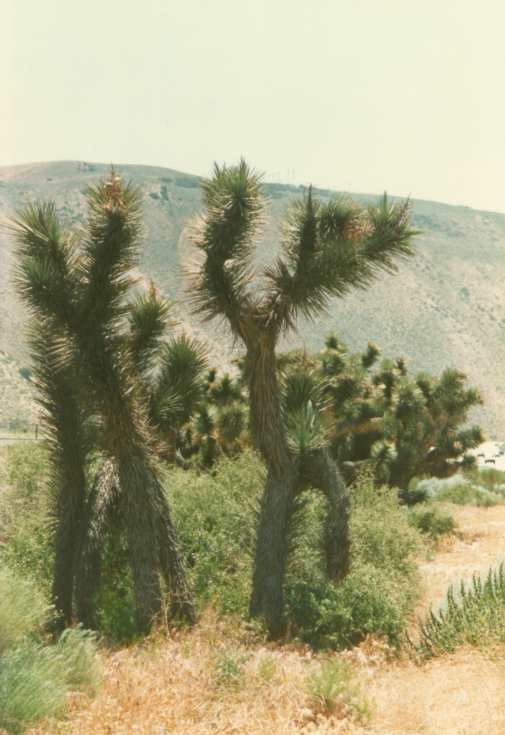 The tree grows to a height of about 20 to 25 feet, has a fibrous bark and long pointed leaves. This is the only place in the United States where the tree is found.
The tree grows to a height of about 20 to 25 feet, has a fibrous bark and long pointed leaves. This is the only place in the United States where the tree is found.
Next we pass Borax, California. This is where the Borax mines are located. Some of you will remember the tales of the 20 mule team wagons shown on TV that hauled the Borax to Los Angeles for processing into detergent products near the end of the last century. Now the product is carried by the Santa Fe Railroad.
Just after passing Borax we come to Edwards Air force Base where all the testing was done in the early days of the space flight program. Chuck Yeager, the first man to break the sound barrier in a plane did all that testing at Edwards. The plane Chuck flew was a rocket powered craft that was carried aloft in the bomb bay of a B-29 super bomber. The small planes would be dropped from the bomber, the engine would then be ignited and the plane would accelerate to the desired speed for the particular test. The powered segment of the flight lasted only a matter of seconds before the fuel supply was exhausted.
All of the flights to test the space shuttle were done at Edwards. And is you remember in all of the early flights the shuttle made it landed at Edwards and was then ferried on the back of a Boeing 747 plane back to Cape Canaveral.
Just past Edwards is Mojave where the plane that flew around the world non-stop without refueling was built, tested, left from on its successful flight and returned to. That is a marvelous story about the courage of the builder of the plane and of the two pilots that flew the plane on its flight.
Then comes California City, whose existence in dependent on Edwards. Most of the people who work at Edwards live in California City. 20 years ago when I first saw California City it was a treeless ugly little place that you could not imagine why anyone would want to live in, now it has trees, a golf course, a nice city park, traffic lights, strip malls and all the things other small cities have. Good? Don’t know. Looks better. Yes. This is the home of the Desert Tortoise. In California the desert tortoise is on the endangered species list, in Arizona it is not.
As we leave Mojave we travel through a pass in the mountains. This pass has hundreds of wind powered electrical generating machines. These machines have gained some popularity over the years but their existence is mostly due to government subsidy not because they are economically profitable.
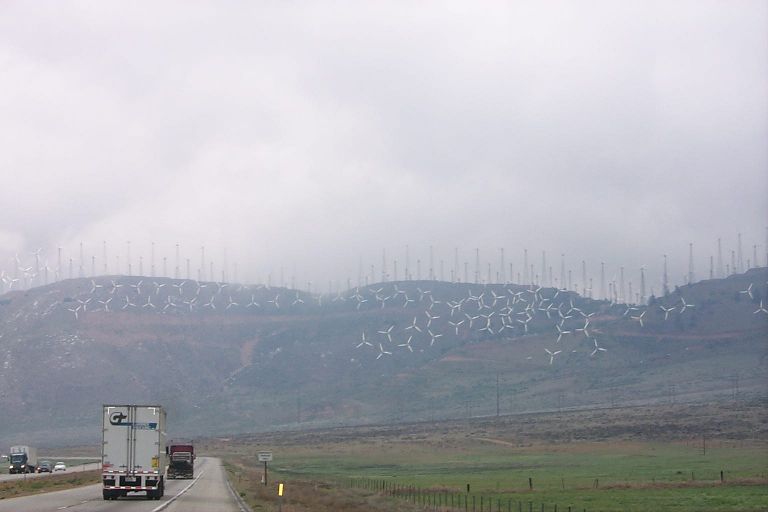 Just after we pass the wind generating machines we enter the beautiful oak studded mountains covered with golden colored grass, this is the California I have come to see. California has gotten an unusual amount of rain the past few years and all of the natural vegetation is very healthy looking. All we need to do is proceed through the mountains for 25 miles and we will be in Bakersfield the home of Merle Haggard and Buck Owens two country western singers. Bakersfield is also the southern end of the San Joaquin Valley one of the world’s most productive farming areas thanks to water made available for irrigation.
Just after we pass the wind generating machines we enter the beautiful oak studded mountains covered with golden colored grass, this is the California I have come to see. California has gotten an unusual amount of rain the past few years and all of the natural vegetation is very healthy looking. All we need to do is proceed through the mountains for 25 miles and we will be in Bakersfield the home of Merle Haggard and Buck Owens two country western singers. Bakersfield is also the southern end of the San Joaquin Valley one of the world’s most productive farming areas thanks to water made available for irrigation.
As we come down out of the mountains we are given a grand view of the farming lands, we pass through fields of citrus trees that have recently been harvested. Next are the fields of grapes that are in the middle of their harvest time. Another sight we are greeted to is semi-trucks loaded with produce, mostly carrots, grapes and garlic. We leave Bakersfield on highway 99 and notice a dramatic increase in the truck traffic.
The next leg of our journey is Bakersfield to San Louis Obispo. After we arrive in San Louis we will have only one leg to go but this is the fun part this is why we came, this is California.
Twenty miles north of Bakersfield we leave highway 99 and head west on a secondary highway 146. The first town on 146 is Wasco the rose capitol of the world. Just before we get into Wasco
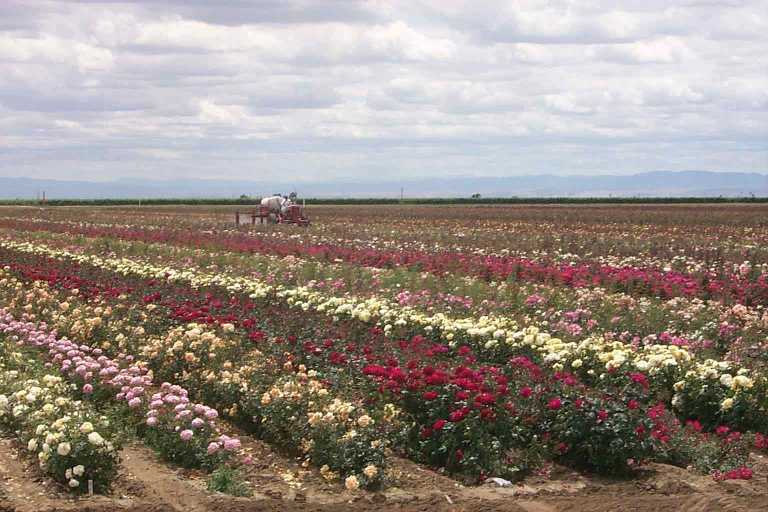 we pass through fields of roses as far as the eye can see. The roses are all colors and beautiful. Next are miles of Pistachio orchards then miles of almond orchards next are more grape vineyards we will pass through 60 or more miles of grapes, but if we were traveling north on highway 99 it would be 100 or more miles of grapes. This is the land of the Gallo Brothers, who used to produce cheap wine in gallon containers from grapes grown in this hot land. Now the same company produces premium wines in small nicely labeled bottles with a hefty price tag from the same vines thanks to the increased demand for wines and improved wine making techniques.
we pass through fields of roses as far as the eye can see. The roses are all colors and beautiful. Next are miles of Pistachio orchards then miles of almond orchards next are more grape vineyards we will pass through 60 or more miles of grapes, but if we were traveling north on highway 99 it would be 100 or more miles of grapes. This is the land of the Gallo Brothers, who used to produce cheap wine in gallon containers from grapes grown in this hot land. Now the same company produces premium wines in small nicely labeled bottles with a hefty price tag from the same vines thanks to the increased demand for wines and improved wine making techniques.
We are now on highway 101 just north of San Luis Obispo. This is where the temperature becomes cool enough to allow us to turn off the air conditioner, open the windows and relax. We have just about made it the, rest is beautiful. The Southern Pacific railroad is just to the right of the highway and will be paralleled until we get to San Juan Bautista. This is my old stomping grounds when I was working in California, t his was my territory, I knew this area from here to northern California as well as anyone. I knew every main road as well as most of the back roads.
We get to the lower end of the Salinas valley just after we start up the 101 highway.
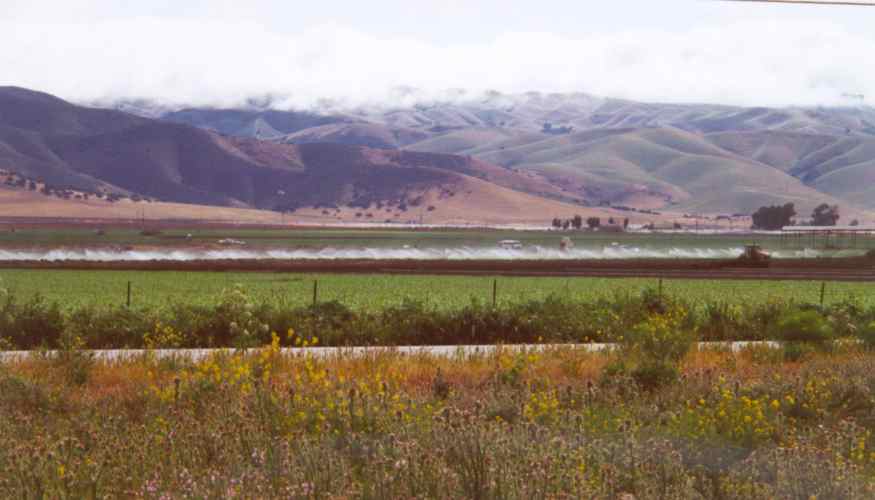
The photograph above was taken just south of Gonzales. The thing that makes California the giant agricultural land is irrigation of the fields shown here. Farmers hope to harvest 4 crops each year in the Salinas Valley. The crop they are not sure of is the one that is planted in January and harvested in March, often this crop gets rained out because the fields are to wet to plant.
 Born 08/13/1925
Born 08/13/1925